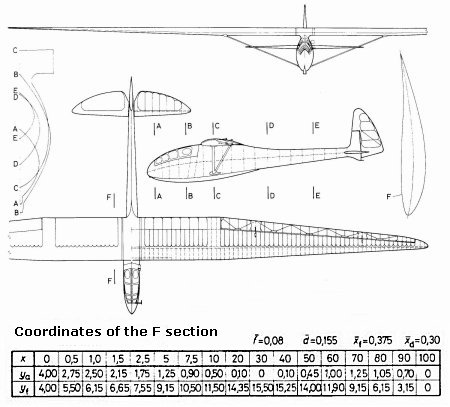HUNGARIAN GLIDERS
1933-2000
| Type designation: | Karakán |
| Name: | Karakán |
| Designer: | Lajos ROTTER |
| Class: | High performance |
| General arrangement: | Strutted high wing, closed cockpit, traditional tail unit |
| Crew: | 1 |
| First flight: | Aug. 4, 1933 |
| Manufacturer: | Boy-Scout Group "Ezermester"; MOVERO workshop |
| Number of built: | 2 |

.jpg)
Short history:
The boy-scout Jamboree in 1933 was held at Gödöllő, Hungary. To represent gliding at the Jamboree Lajos Rotter had been called by the Hungarian Boy-Scout Association to design a glider. Rotter aim was to create a high performance glider suitable to utilize the Hungarian average weather pattern. The glider was built at the workshop of the Boy-Scout Group "Ezermester" of the Magyar Állami Gépgyár (Hungarian Machine Factory). The Jamboree was already commenced when on Aug. 4, 1933 the glider was first launched by bungee-cord at Gödöllő to 'feel' her controls. The next launch was an aerotow.
Robert Kronfeld visited the Jamboree just to fly the Karakán.
Two days later Rotter flew a 64 km cross-country. Again two days later Rotter gained 1840 m height in a cloud, which was the first cloud flight in Hungary as well as a new record. During the following years many Hungarian pilots earned their silver badges flying the Karakán. The first Karakán had been used till the end of 1939, when it was exhibited in the Hungarian Museum of Transportation. Unfortunately it was destroyed in 1944 during an air raid.
The second Karakán had been built at the workshop of MOVERO (Aviation Section of the Hungarian Defense Assotiation) and first flew on Apr. 29, 1935. In 1939 a new Hungarian height gain record of 2212 m was flown by this glider. It was destroyed in a hangar fire in 1940.
Structure: All wooden
Wing:
The 'V' strutted wing had a single main and a light rear spar which the rear strut member was attached to. The central part of the wing has a constant chord and the outer wing panels were tapered to the wingtips. The wing in front of the main spar was covered by plywood creating a torsion resisting box. The other parts of the wing as well as the ailerons were fabric covered.
The airfoil of the the central panel was designed by Rotter, which gradually turned into a symmetrical airfoil at the wingtip. The high span -- high aspect ratio ailerons were tapered together with the wing panels.
Fuselage:
The fuselage had an almond-shape cross-section and was a plywood covered semi-monocoque structure featuring strong longerons at the top and bottom lines. The comfortable cockpit had a semi-enclosed transparent canopy with large oval openings.
The landing gear consisted of a long rubber-ring dumped skid covered on the sides by heavy canvas.
Tail unit:
It was traditionally arranged with an all moving elevator. The vertical stabilizer area was small. The leading edges of the elevator and rudder was plywood, the other parts were fabric covered.
.jpg)

| Dimensions: |
| Wing: |
| Span, m: | 20 |
| Area, m2: | 20,7 |
| Aspect ratio: | 19,4 |
| Chord (root), m: | 1,45 |
| Chord (tip), m: | 0,3 |
| Airfoil (root), m: | Special |
| Airfoil (mid-span), m: | Special |
| Airfoil (tip), m: | Special |
| Dihedral, degree: | 1 |
| Sweep, degree: | 0 |
| Washout: | Aerodynamic and -1,5 degree geometric |
| Aileron: |
| Span, m: | 6,5 |
| Mean chord, m: | cca. 0,25 |
| Total area, m2: | 3,21 |
| Balancing: | ? |
| Flap: |
| Type: | None |
| Airbrakes: |
| Type: | None |
| Horizontal stabilizer: |
| Span, m: | None |
| Elevator: |
| Span, m: | 4,0 |
| Area, m2: | ? |
| Airfoil: | ? |
| Balancing: | Aerodinamic |
| Trim: | ? |
| Vertical stabilizer and rudder: |
| Total area, m2: | ? |
| Rudder area, m2: | ? |
| Balancing: | Aerodinamic |
| Fuselage: |
| Length, m: | 7,97 |
| Width, m: | 0,55 |
| Height: | cca. 1,15 |
| Cross section, m2: | ? |
| Landing gear: |
| Type: | Skid with rubber-ring dumping |
| Masses: |
| Wing, kg: | ? |
| Fuselage, kg: | ? |
| Tail unit, kg: | ? |
| Empty glider, kg: | 217 |
| Gross, kg: | 297 |
| Ballast, kg: | None |
| Wing loading, kg/m2: | 14,4 |
| Speeds: |
| VNE, km/h: | ? |
| Max. aerotow speed, km/h: | ? |
| Max. winch speed, km/h: | ? |
| Max. speed in rough air, km/h: | ? |
| Stall speed, km/h: | ? |
| Performance: |
| Min. sink, m/s (at gliding speed, km/h): | 0,65/? |
| Best L/D (at gliding speed, km/h): | 22/? |
| Start methods: | Bungee, Winch, Aerotow |

Origin of data and 3-view drawing:
Jereb Gábor: Magyar vitorlázó repülőgépek, Műszaki Könyvkiadó, 1988, Budapest
(Gábor JEREB: Hungarian Gliders, Technical Publishing House, 1988, Budapest)
Gábor FEKECS E-mail: fekecs.gabor@t-online.hu

.jpg)
.jpg)
